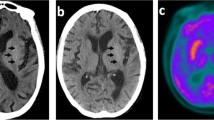Abstract
Hyperglycemia-induced unilateral basal ganglion lesions occur mostly in Asian patients. A signal abnormality in the basal ganglion region is evident on these patients’ neuroimaging. Despite characteristic imaging findings and clinical manifestations, the underlying mechanism is still unclear. To clarify the underlying pathophysiology of unilateral basal ganglion lesions, we examined the [18F]-fluorodeoxyglucose (FDG) positron emission tomography (PET) findings in 3 patients with hyperglycemia. The PET studies were performed at 3 weeks, 5 weeks, and 7 months after clinical onset. The markedly reduced rates of cerebral glucose metabolism in the corresponding lesions on T1-weighted magnetic resonance images provided direct evidence of regional metabolic failure. We suggest that the metabolic derangements associated with hyperglycemia and vascular insufficiency contribute to regional metabolic failure in patients with poorly controlled diabetes mellitus.
Similar content being viewed by others
References
Aiegler D, Langen KJ, Herzog H, Kuwert T, Muhlen H, Feinendegen LE, Gries FA (1994) Cerebral glucose metabolism in type 1 diabetic patients. Diabet Med 11:205–209
Auer RN, Benveniste H (1997) Hypoxia and related conditions. In: Graham DI, Lantos PL (eds) Greenfield’s neuropathology. London: Edward Arnold, pp 263–314
Fujioka M, Taoka T, Hiramatsu KI, Sakaguchi S, Sasaki T (1999) Delayed ischemic hyperintensity on T1-weighted MRI in the caudoputamen and cerebral cortex of humans after spectacular shrinking deficit. Stroke 30:1038–1042
Fujioka M, Taoka T, Matsuo Y, Mishima K, Ogoshi K, Kondo Y, Tsuda M, Fujiwara M, Asano T, Sakaki T, Miyasaki A, Park D, Siesjö BK (2003) Magnetic resonance imaging shows delayed ischemic striatal neurodegeneration. Ann Neurol 54:732-747
Grill V, Gutniak M, Bjorkman O, Lindqvist M, Stone-Elander S, Seitx RJ, Blomqvist G, Reichard P, Widen L (1990) Cerebral blood flow and substrate utilization in insulin-treated diabetic subjects. Am J Physiol 258:E813–E820
Henkelman RM, Watts JF, Kucharczyk W (1991) High signal intensity in MR images of calcified brain tissue. Radiology 179:199–206
Inoue E, Hori S, Narumi Y (1991) Portal-systemic encephalopathy: presence of basal ganglia lesions with high signal intensity of MR images. Radiology 179:551–555
Kjos BO, Brant-Zawadzki M, Young RG (1983) Early CT findings of global central nervous system hypoperfusion. Am J Neuroradiol 141:1227–1232
Lee MS, Marsden CD (1994) Neurological sequelae following carbon monoxide poisoning, clinical course and outcome according to clinical types and brain computed tomography scan findings. Mov Disord 9:550–558
Lin JJ, Chang MK, Lee CC, Tsao WL (1995) Hemiballism-hemichorea: clinical study in 23 Chinese patients. Zhonghua Yi Xue Za Zhi (Taipei) 55:156–162
Lin JJ, Lin GY, Shih C, Shen WC (2001) Presentation of striatal hyperintensity on T1-weighted MRI in patients with hemiballism-hemichorea caused by non-ketotic hyperglycemia: report of seven new cases and a review of literature. J Neurol 248:750–755
Oh SH, Lee KY, Im JK, Lee MS (2002) Chorea associated with non-ketotic hyperglycemia and hyperintensity basal ganglia lesion on T1-weighted brain MRI study: a meta-analysis of 53 cases including four present cases. J Neurol Sci 200:7–62
Ohara S, Nakagawa S, Tabata K, Hashimoto T (2001) Hemiballism with hyperglycemia and striatal T1-MRI hyperintensity: an autopsy report. Mov Disord 16:521–525
Shan DE, Ho DMT, Chang C, Pan HC, Teng MM (1998) Hemichoreahemiballism: an explanation for MR signal changes. Am J Neuroradiol 19:863–870
Shimomura T, Nozaki Y, Tamura K (1995) Hemichorea-hemiballism associated with nonketotic hyperglycemia and presenting with unilateral hyperintensity of the putamen on MRI T1-weighted images–a case report. No To Shinkei 47:557–561
Author information
Authors and Affiliations
Corresponding author
Rights and permissions
About this article
Cite this article
Hsu, J.L., Wang, HC. & Hsu, WC. Hyperglycemia-induced unilateral basal ganglion lesions with and without hemichorea A PET study. J Neurol 251, 1486–1490 (2004). https://doi.org/10.1007/s00415-004-0571-4
Received:
Revised:
Accepted:
Issue Date:
DOI: https://doi.org/10.1007/s00415-004-0571-4




